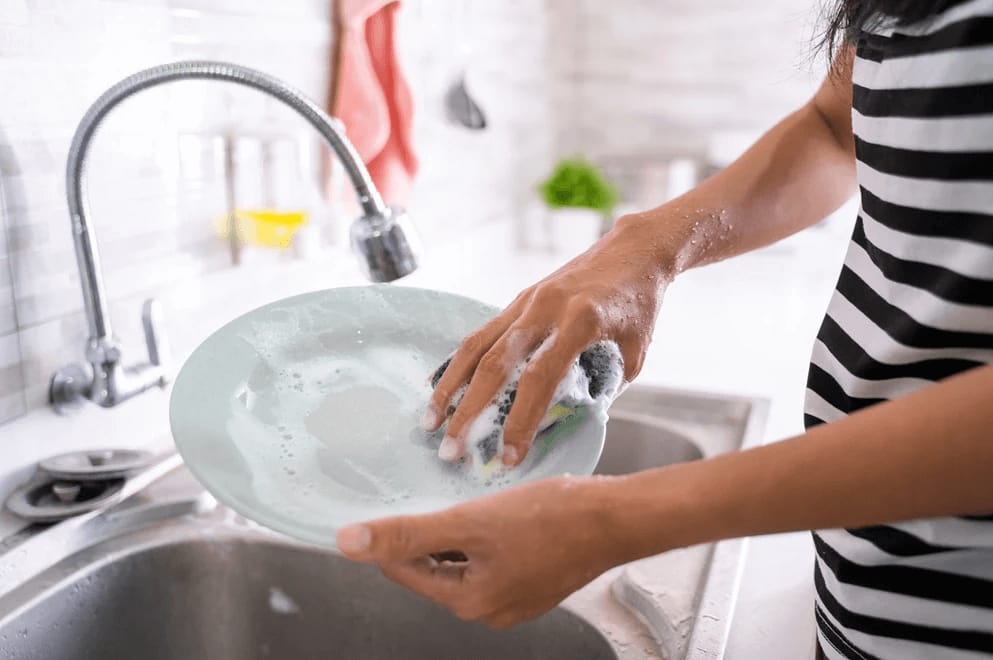- Thriving Guide
- Posts
- How a Dish Soap Allergy Can Affect Your Skin
How a Dish Soap Allergy Can Affect Your Skin
Red, itchy hands after doing the dishes? Here's how to identify, treat, and prevent a reaction to dish soap and when it might be more than just dry skin.

Washing dishes may feel like a simple daily chore, but for some people, it can come with an uncomfortable side effect: irritated, itchy, or inflamed hands. If you've noticed red patches or dry, stinging skin after using dish soap, you might be experiencing a dish soap allergy commonly caused by a condition called contact dermatitis.
This reaction is more common than you might think, and understanding what causes it can help you protect your skin and find relief.
What Is Contact Dermatitis?
Contact dermatitis is a type of skin inflammation triggered by direct contact with a substance that irritates the skin or triggers an allergic reaction. It typically affects the hands when it’s caused by dish soap and can show up quickly or after repeated use.
There are two main types of contact dermatitis:
Irritant Contact Dermatitis: Caused by harsh ingredients like detergents, soaps, or acids. It's the most common form and can happen with a single exposure or over time with repeated contact.
Allergic Contact Dermatitis: Results from an allergic response to a specific ingredient. It may not appear immediately in fact, it can take weeks, months, or even years of using the same product before your body starts to react.
Common Allergens in Dish Soap
Dish soaps often contain a complex mix of ingredients that can be harsh on the skin. Some of the most common culprits include:
Fragrances – These are often blends of synthetic chemicals and are a leading cause of allergic reactions in skincare products.
Sodium Lauryl Sulfate (SLS) – A foaming agent that can strip natural oils and irritate the skin barrier.
Triclosan – An antibacterial agent previously used in many household products, now linked to skin irritation.
Because dish soap is not always regulated as strictly as personal care products, it can be hard to pinpoint which ingredient is to blame. Look for ingredient lists and consider switching to fragrance-free or hypoallergenic alternatives.
Symptoms to Watch For
The most common signs of a dish soap allergy or irritation include:
Red, inflamed skin on the hands
Itching or burning sensation
Dry, cracked, or scaly patches
Small blisters or bumps (in more severe cases)
Allergic contact dermatitis symptoms usually appear 24–48 hours after exposure, though some reactions may take longer to develop.
Getting a Diagnosis
If you suspect your dish soap is causing a reaction, a healthcare provider can perform a physical exam and ask questions about your exposure to household products. In some cases, a patch test may be used to identify specific allergens.
Be ready to provide the brand and ingredients of your dish soap, as well as details about your hand care routine.
How to Treat a Dish Soap Allergy
Many cases of dish soap-related skin irritation can be managed at home, especially if caught early.
At-Home Remedies:
Rinse hands thoroughly with cool water after dishwashing
Apply cold compresses to relieve itching
Try an oatmeal soak or bath for soothing relief
Use non-latex, non-rubber gloves for protection during chores
Over-the-Counter Relief:
Fragrance-free moisturizers to restore the skin barrier
Topical corticosteroids to reduce inflammation
Oral antihistamines if itching is severe
Cooling gels or creams designed for irritated skin
If symptoms persist or worsen, a prescription cream or further allergy testing may be necessary.
Safer Dishwashing Alternatives
“Natural” or “organic” dish soaps aren't always safe for sensitive skin many still contain fragrances or preservatives. Instead, consider:
Fragrance-free soaps
Preservative-free formulas
Simple hand soaps for light dishwashing tasks
Homemade soap options with limited, known ingredients
Also, using barrier gloves (free from latex, if you're sensitive) can help prevent flare-ups and protect healing skin.
When to See a Healthcare Provider
It’s time to consult a medical professional if:
Your rash is severe, spreading, or painful
Home treatments don’t bring relief within a few days
You develop a fever or the area becomes warm and tender (possible signs of infection)
Your provider can recommend stronger medications or help identify the root allergen through testing.
The Bottom Line
What seems like a minor irritation from dish soap could actually be an allergic reaction or chemical sensitivity. Whether it’s the fragrance, preservatives, or foaming agents in your soap, consistent exposure can trigger symptoms over time. Thankfully, switching to gentle, fragrance-free products and using skin-protective habits can go a long way in keeping your hands healthy.
If you found this article helpful, share it or subscribe to our newsletter for more wellness insights.